Physical Address
304 North Cardinal St.
Dorchester Center, MA 02124
( Box 15-1 )
Vocal cord nodules/polyps
Laryngocele and laryngeal cysts
Contact ulcer
Amyloidosis
Subglottic stenosis
Teflon granuloma
Tracheopathia osteoplastica
Infectious diseases
Necrotizing sialometaplasia
Radiation-induced changes
Benign epithelial changes
Others
Definition: Non-neoplastic stromal reactive process related to inflammation and/or trauma.
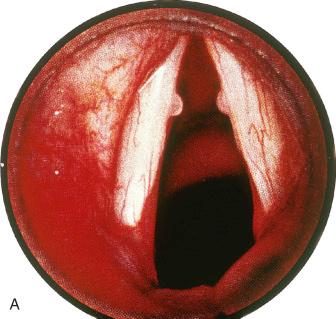
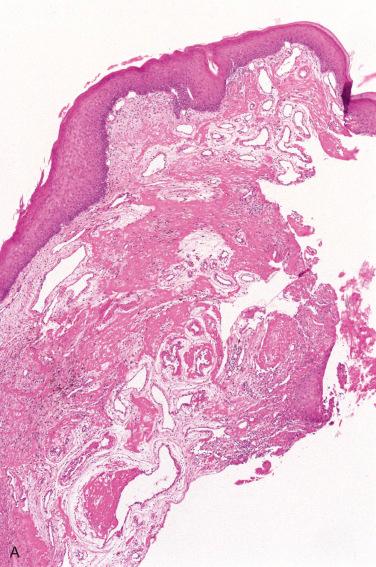
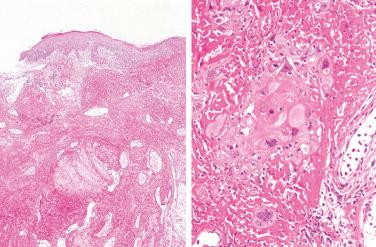
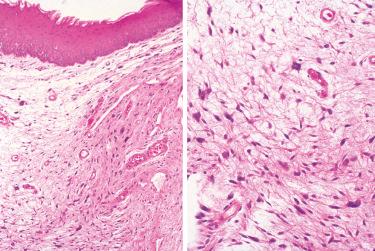
Synonyms: Screamer's, singer's, or preacher's nodules; corditis nodosa; diffuse polyposis (involvement of the entire vocal cord)
No gender predilection; may be seen in all age groups but most common from the third to sixth decades
Clinicians distinguishing between nodules and polyps based on whether the lesion(s) is (are) sessile (nodule) or pedunculated (polyp)
Regardless of terminology, the symptoms related to vocal cord polyps and nodules are similar and include hoarseness or voice changes (“breaking” of the voice).
May be a single lesion arising from the true vocal cord or bilateral lesions involving the anterior or middle third of the true vocal cord:
May occur anywhere along the vocal cord but most occur on the free edge at the junction of the anterior and middle thirds
Point of maximal vibratory impact in the vocal cord is in the middle third of the true vocal cord (membranous cord), representing the most common site for polyps or nodules to occur.
Follows voice abuse (phonatory trauma), infection (laryngitis), alcohol, smoking, or endocrine dysfunction (hypothyroidism):
Phonatory trauma is a central cause of nodule/polyp formation.
Infrequently, hypothyroidism may cause vocal cord edema, which may progress to formation of a myxoid polyp.
Helicobacter pylori (HP), a common cause of gastritis and/or gastroespohageal reflux disease, may be associated with vocal fold minimal lesions (VFML) (e.g., polyps, nodules, contact ulcers):
HP can be detected by immunohistochemical staining or reverse transcriptase polymerase chain reaction (RT-PCR) in biopsies from patients with VFML.
Direct cause and effect between presence of HP and polyps/nodules not established
Videostroboscopic examination of the glottal cycle is useful in the differential diagnosis of small lesions of the vocal fold cover that cannot be easily visualized:
An isolated lesion shows:
Irregular, incomplete closure
Reduced amplitude of vibration and mucosal wave on the vocal fold on the side of the lesion
Bilateral lesions of longer duration show:
Greater reduction in vibratory amplitude and mucosal wave due to increased submucosal fibrosis and perhaps presence of surface keratinization
Fusiform swelling, sessile, or pedunculated lesion(s) with a soft, rubbery, or firm consistency, white, tan, pearly, glistening, or red appearance measuring from a few millimeters up to 1 to 1.5 cm in greatest dimension
Pathologic process occurs in Reinke's space, the area lying deep to the true vocal cord, which is essentially devoid of blood vessels and in response to injury has a tendency to accumulate fluid.
Histologic subtypes include:
Edematous-myxoid:
Submucosal accumulation of pale blue to pink material admixed with a sparsely cellular and variably vascularized stroma
Fibrous:
Moderately cellular submucosa consisting of uniform oval to spindle-shaped cells associated with a varying amount of fibrous tissue deposition
Vascular:
Submucosa is marked by prominent dilated vascular spaces with or without associated hemorrhage.
Hyaline:
Dense eosinophilic submucosal deposition of fibrin material often closely apposed to vascular spaces
May suggest the presence of amyloid (Congo red staining is negative)
Mixed:
Combination of the above subtypes in a single lesion
For all types the overlying epithelium may be atrophic, hyperplastic, and keratotic; rarely, dysplastic epithelium and/or invasive carcinoma may be identified.
Histologic changes represent different tissue reactions to the initiating event and do not represent progressive (sequential) changes.
Rarely, atypical stromal cells (i.e., myofibroblasts) similar to those seen in sinonasal inflammatory polyps may be present, which are:
Characterized marked by nuclear enlargement and hyperchromasia
Not associated with either increased mitotic activity nor a subepithelial condensation of stromal cells (“cambium layer”)
Typically scattered in distribution over a wide area and do not appear concentrated in location or characterized by hypercellularity
Histochemistry:
Negative staining for amyloid (Congo red, crystal violet, or thioflavin T stains)
Cytogenetics and molecular genetics:
Messenger RNA genotypic profiles for extracellular matrix proteins, including procollagen I, collagenase, elastase, fibronectin, fibromodulin, decorin, hyaluronic acid synthase 2, and hyaluronidase correlated to a videostroboscopic parameter of mucosal wave stiffness showed:
Vocal cord polyps, characterized by stiffer mucosal waves, have higher levels of gene expression.
Reinke's edema, characterized by stiffer mucosal wave scores, has lower gene activity levels.
Generally, there is a good correlation between the clinical findings/diagnosis of vocal cord polyps/nodules and the histopathologic findings; however, except for cysts that are epithelial lined, there may be a lack of correlation between vocal fold lesions that may be clinically distinct (e.g., polyps, nodules, Reinke edema, others) and the histopathologic diagnosis/classification:
May be overlapping histologic finding including epithelial hyperplasia, basement membrane thickening, edema, vascular proliferation, and extracellular “amyloid-like” fibrin
No histologic feature that reliably distinguished among the lesions
In cases in which there may be a lack of correlation between the clinical diagnostic considerations and the histologic diagnosis, treatment should be individualized based on clinical judgment.
Myxoma:
True myxomas are rarely encountered in the larynx.
Typically occurs in supraglottic larynx rather than vocal cord (i.e., gottis) where polyps/nodules occur
Typically large (≥3 cm or larger) rather than small size of polyps/nodules
Tend to be avascular as compared with well-vascularized nature of polyps/nodules
Typically are not covered by surface epithelium as compared with polyps/nodules that typically include overlying surface (squamous) epithelium
Amyloidosis:
Hyaline-type vocal cord nodule may be misinterpreted as amyloid deposition; however, staining for amyloid differentiates between these entities.
Hemangioma
Fibroma
Neurofibroma:
Neurofibromas are S100 protein and Sox10 positive.
Vocal cord polyps/nodules S100 protein and Sox10 negative
In rare examples showing atypical stromal cells the differential diagnosis may include a malignant neoplasm, including sarcoma (e.g., rhabdomyosarcoma) and carcinoma (e.g., spindle cell squamous carcinoma):
Laryngeal sarcomas are rare; the most common type of sarcoma of the larynx is a chondrosarcoma (see Chapter 16 ).
Atypical stromal cells in a polyp/nodule tend to be localized as compared with diffuse cellularity and nuclear atypia, including increased mitotic activity seen in association with a sarcoma.
Surgery:
Laser surgery can be used safely in the larynx to remove benign superficial laryngeal lesions.
Voice therapy:
Postoperative voice therapy decreases the risk of recurrence.
Vocal cord nodules/polyps can recur up to 5 years after diagnosis/therapy.
Definition: Abnormal dilatation of the saccule (appendix of the ventricle) containing air and maintaining an open communication with the laryngeal lumen.
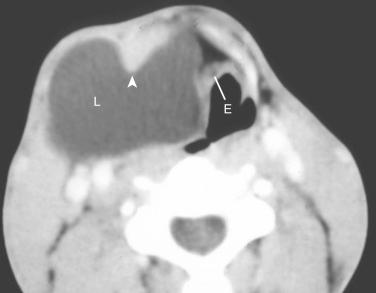
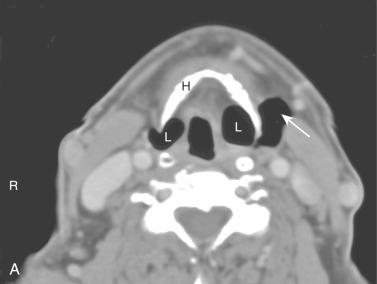
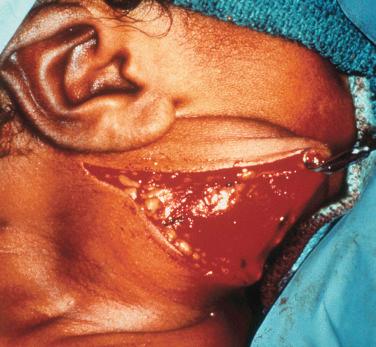
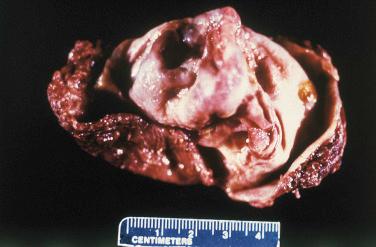
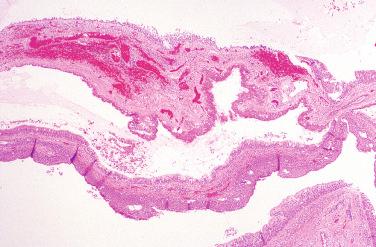
No gender predilection; most common in the fifth through eighth decades of life:
May occur in pediatric ages
Majority are unilateral but may be bilateral in up to 25% of patients.
Three types of laryngoceles identified:
Internal laryngocele: dilatation confined to the intrinsic larynx:
Reported incidence of 30%
External laryngocele: dilated sac projects upward between the false vocal cord and the thyroid cartilage and laterally through the thyrohyoid ligament into the neck:
Reported incidence of 26%
Mixed (combined) laryngocele is a combination of internal and external laryngoceles:
Reported incidence of 44%
Symptoms include:
Hoarseness, coughing, dyspnea, dysphagia, and sensations of foreign body or mass in the throat
External or mixed laryngoceles may present as:
Lateral neck mass that fluctuates with changes in intralaryngeal pressure and is compressible
Subcutaneous emphysema
Infected laryngoceles (laryngopyocele) associated with pain and tenderness
Diagnosis of laryngocele is a clinical one:
Despite clinical assurance of a diagnosis of a laryngocele, prudent therapy would include additional examination to rule out the presence of a neoplasm.
Radiology:
Thin-walled air-filled cystic lesion communicating with laryngeal ventricle
CT (non–contrast-enhanced):
Internal laryngocele:
Low-density mass in supraglottic space
Mixed laryngocele:
Low-density, thin-walled mass seen in the low submandibular space
Can be followed into larynx through thyrohyoid membrane
Internal component may be collapsed or dilated.
Infected laryngoceles by contrast-enhanced CT have a thick, enhancing wall surrounding the laryngocele.
Cause:
Laryngoceles can be congenital or acquired:
Acquired laryngoceles are related to occupation and include professions in which there is a tendency to excessively increase intralaryngeal pressures, which may result in the development of a laryngocele (e.g., glassblowers, musicians, and weight lifters).
Laryngoceles may have a coexistent (squamous cell) carcinoma:
Laryngoceles associated with carcinoma tend to be of the internal type.
Not as impressive as the clinical presentation; resected specimen is a smooth-surfaced, sac-like structure that may be devoid of fluid or if infected may contain pus.
Respiratory epithelial-lined (ciliated, columnar) cyst with a fibrous wall
Squamous metaplasia may be seen focally or, if infected, may completely replace the respiratory epithelium; in the presence of infection, a chronic inflammatory cell infiltrate may be seen in the wall of the cyst.
Oncocytic metaplasia of the lining epithelium or minor salivary glands may be seen.
Branchial cleft cyst
Oncocytic papillary cystadenoma
Laryngeal cysts:
Ductal cysts and saccular cysts (see below)
Asymptomatic cases require no treatment.
Surgery may be necessary in those cases that become large and symptomatic.
Microlaryngoscopy involving use of CO 2 laser has become the main therapeutic procedure for the treatment of internal laryngoceles.
An external approach is main therapeutic approach for the treatment of combined laryngocele.
Complications associated with laryngoceles include airway obstruction and infection (laryngopyocele):
For laryngopyoceles the initial treatment is by incision and drainage followed by antibiotic therapy and then surgical excision after the infection has been controlled.
Rare complications include vocal cord paralysis and death due to asphyxia.
Definition: Obstruction of the orifice of the laryngeal saccule or obstruction of the mucous gland ducts of the laryngeal saccule with subsequent accumulation of secretions resulting in cyst formation.
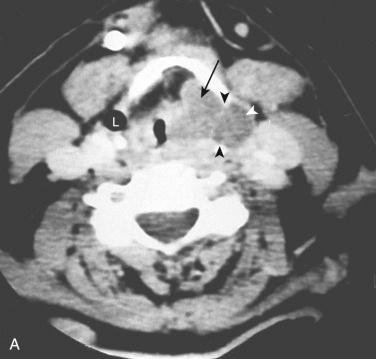
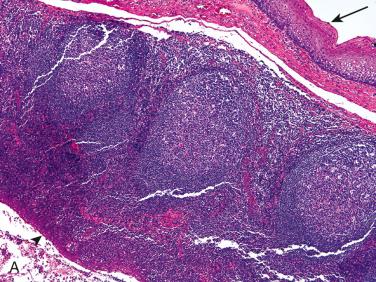
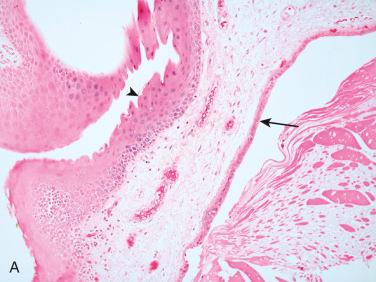
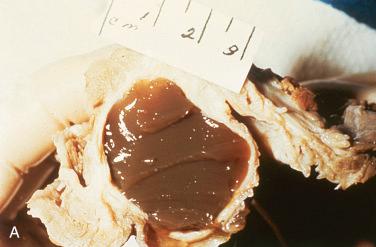
Synonyms: Saccular cyst; ductal cyst; oncocytic cyst; epithelial cyst
Laryngeal cysts have been divided into two categories:
Ductal cysts:
Due to obstruction of the mucous gland ducts
Represent 75% of all laryngeal cysts
Saccular cysts:
Due to obstruction of the orifice of the laryngeal saccule
Represent 25% of all laryngeal cysts
No gender predilection; occur over a wide age range but tend to be most common in individuals older than the sixth decade of life
May occur in pediatric ages
Majority of cysts occur in the supraglottic larynx; less frequently, glottic and subglottic cysts occur.
Ductal cysts:
Majority occurs in the area of the true vocal cords but not in the region of the free margin, which lacks glands.
Next most common site is epiglottis
Less frequent sites include false vocal cords, ventricles, aryepiglottic folds, arytenoids, piriform sinus, anterior commissure, and subglottis.
Saccular cysts:
Occur in the supraglottic larynx:
Majority occurs in the region of the ventricles
Less often occur in the region of the aryepiglottic folds, lateral larynx
Saccular cysts can be further subdivided into anterior and lateral cysts, depending on the location, level of obstruction, and length of the saccule:
Anterior:
Develop near the orifice of the ventricle overhanging the anterior glottis
Represent the majority of cases
Lateral:
Bulge into the aryepiglottic folds, false vocal cords, or epiglottis
Rarely present as a neck mass with the cyst extending through the thyrohyoid membrane.
Other cysts types include tonsillar-type, epithelial, and oncocytic (require histologic confirmation—see below):
Tonsillar-type cyst:
Occurs primarily in the epiglottis, vallecula, or piriform sinus
Epithelial cyst:
Occurs primarily in the piriform sinus or vallecula
Oncocytic cyst:
Occurs primarily in the false vocal cords and ventricles
In general, laryngeal cysts may be solitary or multiple.
Symptoms include:
Asymptomatic and identified incidentally
Hoarseness, coughing, dyspnea, dysphagia, sensation of foreign body in the throat, neck mass, pain
Infants may present with feeding problems.
Radiology:
Fluid-filled cystic lesion in supraglottic larynx
Cause:
Laryngeal cysts can be congenital or acquired:
Supraglottic cysts are due to obstruction of the orifice of the laryngeal saccule or obstruction of the mucous gland ducts of the laryngeal saccule with subsequent accumulation of secretions.
Glottic cysts may be due to vocal cord abuse.
Subglottic cysts may occur after intubation.
Congenital cysts may associated with other congenital or developmental abnormalities, including:
Down syndrome, cystic fibrosis, cardiac anomalies, laryngomalacia, conductive hearing loss, hydrocephalus, microcephalus, micrognathia, others
Ductal cysts:
Usually measure less than 1 cm in diameter
Tend to be superficial
Saccular cyst:
Submucosal range in size from 1 to more than 7 cm in greatest dimension.
Ductal and saccular cysts are lined by respiratory or squamous epithelium:
Histologic differentiation of ductal from saccular cysts is not possible, and this differentiation rests on clinical parameters.
Cyst may be lined by an oncocytic epithelium.
Other histologic cyst types include:
Tonsillar type cyst:
Resembles palatine tonsillar crypt
Lined by stratified squamous and/or reticulated epithelium
Keratin-filled lumen
Lymphoid follicles with germinal centers seen in cyst wall
Epithelial cyst:
Lined by respiratory and/or squamous epithelium or an flattened (attenuated) epithelium
Epithelial lining may be papillary in architecture.
May contain keratin or mucin
May have lymphoid component in cyst wall
Oncocytic cyst:
Lined by oncocytic epithelium
May have prominent papillary architecture and referred to as oncocytic papillary cyst or oncocytic papillary cystadenoma
Aside from the above, oncocytic metaplasia and hyperplasia can be seen in association with other laryngeal lesions, and these changes most likely represent an aging (metaplastic) phenomenon.
Branchial cleft cyst
Laryngocele
Conservative management is often advocated to include needle aspiration, deroofing of the cyst, laser marsupialization, or endoscopic removal:
Especially for infants and children to avoid stenosis
Smaller anterior saccular cysts can be managed by endoscopic excision.
Saccular cysts can be managed endoscopically in many cases, but if persistent after two or three endoscopic procedures, a prolonged course can be anticipated.
Larger saccular cysts tend to recur repeatedly.
Complete excision, endoscopically or through an external surgical approach, may shorten the clinical course.
Tracheotomy may be required, some under emergent conditions.
Definition: Benign, tumor-like condition occurring most commonly along the posterior aspect of one or both vocal cords.
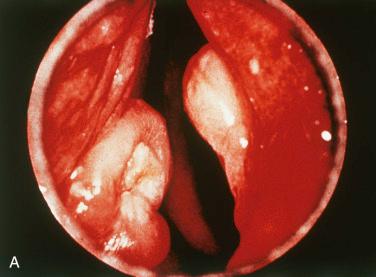
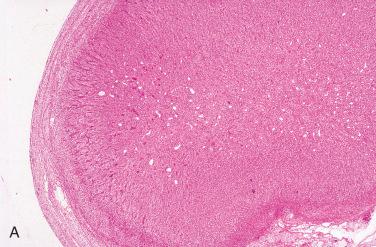
NOTE: Although termed as an ulcerative process, not infrequently due to chronicity of disease areas of the lesion may be ulcerated and other areas may show epithelial hyperplasia, the latter a reactive/regenerative process.
Synonyms: Pyogenic granuloma of the larynx; intubation granuloma
More common in men than women; occur over a wide age range:
Generally seen in the adult population
Uncommon in children but not restricted to any specific age group
Most common site of occurrence is along the posterior aspect of one or both vocal cords primarily in the area of the vocal cord process of the arytenoid cartilage:
Propensity for contact ulcers to occur along the posterior vocal cords includes:
Posterior vocal cord experiences the greatest excursion during opening and closing of the glottis.
Mucoperichondrium overlying the posterior vocal cord is extremely thin and more susceptible to injury.
Additionally, the subepithelial connective tissue in this area is relatively sparse.
Although the majority occurs along the posterior vocal cords, other vocal cord sites may be affected.
Symptoms include:
Hoarseness most common
Less commonly, may include dysphagia, sore throat, dysphonia, difficulty breathing, choking, foreign body sensation in the throat, and pain
Duration of symptoms may be from weeks to years.
Etiologic factors include:
Gastroesophageal reflux disease (GERD) with acid regurgitation
Not infrequently patients may be unaware of their condition and while supine during sleep the refluxed acid injures the posterior cord resulting in contact ulcer
Tends to be more common in men
Helicobacter pylori (HP) may be detected by immunohistochemical staining or reverse transcriptase polymerase chain reaction (RT-PCR):
HP also may be identified in oral cavity, sinonasal tract, pharynx, and middle ear mucosa.
Direct cause and effect between HP and development of contact ulcer and/or other upper aerodigestive tract lesions (non-neoplastic and neoplastic) not established
Vocal abuse:
Shouting, persistent coughing, or throat clearing
Tends to be more common in men
Postintubational trauma:
Postintubational contact ulcers tend to occur more frequently in women as a result of the smaller luminal diameter seen in women.
Lesions may not become manifest until weeks to months after intubation injury.
Ulcerated, polypoid, nodular, or fungating mass with a beefy red to tan-white appearance ranging in size up to 3 cm in diameter
Become a Clinical Tree membership for Full access and enjoy Unlimited articles
If you are a member. Log in here